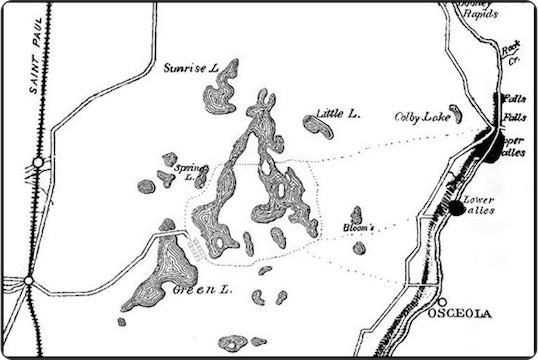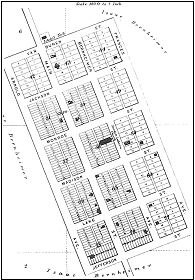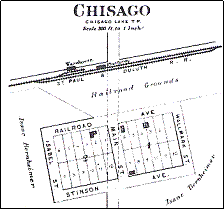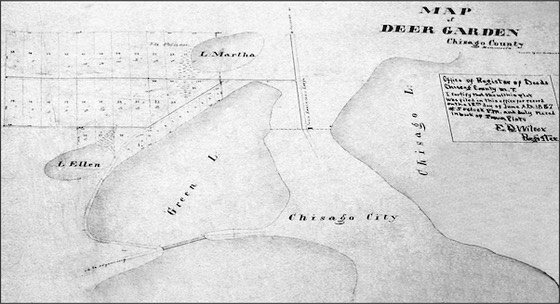Beginnings
Chisago City was founded in 1855. The name Chisago comes from the Chippewa (Ojibwe) name referring to Chisago Lake (Kichi-saga sagiagan), which, at that time, included North and South Center, North and South Lindstrom and Chisago Lake (since separated by many roads). Kichi means large, saga means fair or lovely, and it was both. Described at the time: “It has fully fifty miles of meandering shore line. Its shores and islands are well timbered with maple and other hard woods. It has no waste swamps, or marsh borders.” from Fifty Years in the Northwest, published in 1888 by William H.C. Folsom.
Map showing the area as it existed in the 1870s.
In the map above, Chisago Lake is the large horseshoe-shaped lake and surrounds several islands. The city of Lindstrom is on the top half of the peninsula jutting up between the East and West sides. The dark blotches on the St. Croix River represent copper deposits. The natural commerce of the area in the early years was in lumber and copper.
When the original settlers, represented by William H.C. Folsom of Taylors Falls, petitioned to separate from Washington County in 1851, Chisaga (with an ‘a’) was proposed. However, at the capital in St. Paul, the Indian name was ridiculed, and those in opposition proposed Hamilton, Jackson, Franklin, and Jefferson. But after arguing and winning their case, instead of passing the bill with the correct spelling, the legislature, by error, misspelled the name as Chisago, as it remains to this day. The original settlement (see map at left) was about 1 mile south of the current downtown and is now referred to as Old Towne. In 1865, the city was successful in having the County seat re-located to Chisago City (for 10 years) before it finally ended up in Centre City. For several decades, all aspects of the new community were served by the church and businesses in this 15-block area (such as post office, school, hotel, blacksmith, and general merchandise store).
In 1880, the railroad came through the area, but not near enough to Old Towne. So, the focus of the community started to change to where the downtown is now. Unfortunately all of the original public buildings in the Old Towne area are now gone. The buildings either burnt down, or were replaced. The only close approximation we have of the original structures of that period (in Old Towne) is the Zion Evangelical Lutheran Church, which burnt down but was immediately rebuilt in 1908.
Old Towne Chisago City
The initial settlement of Chisago City was nestled between Green Lake and Chisago Lake, approximately one mile south of the current downtown. Immigrant settlers arrived at the Osceola and Franconia boat landings and migrated west to found this new settlement. According to Warren Upham in “Minnesota Place Names” the community was established and named “Chisago City” in 1855.
The new settlement was platted by Isaac Bernheimer (aged 42), a rich New York cloth merchant) and his brother-in-law Simon W. Arnold (aged 28). How Bernheimer and Arnold came to invest in Minnesota land, and in Chisago City specifically, is still somewhat of a mystery. They eventually controlled about 15,000 acres in Minnesota, of which almost 7,000 were in Chisago County.
The original plat was larger than generally known, and included some street names that no longer exist: Chisago, Kate (Bernheimer’s daughter), Frances, Bernheimer, Sweden, Philadelphia, Clinger (the first post-master), Lake, Phillips, and a smattering of Presidential names. There are, however, a number of original street names that have survived: Arnold Avenue (after Simon Arnold), Isabel Street (Isabella was Bernheimer’s wife), Bloom Street (the Bloom Family owned the J.A. Bloom & Brother General Merchandise Store, and ran the Post Office), Dahl Avenue (after Frank Dahl, owner of the Dahl House Resort), Stinson Avenue (after James Stinson, a large landowner in the 1850s), and Wallmark Lake and Wallmark Street (named for Otto (county auditor and state senator) and Andrew Wallmark (registrar of deeds and sheriff) and other important community positions. The lakes Emily, Ellen, and Martha were named for now forgotten ladies.
The small community prospered. They soon had a general merchandise store, a hotel, and a stave mill. In November of 1856, the second post office in Chisago County was established here with Henry Clinger as its postmaster.
In 1874, Chisago City residents, who had previously traveled to Center City in order to attend church services, decided to establish a church of their own – the Zion Swedish Evangelical Lutheran Church. At the same time, they set aside a plot of land to be used as their cemetery. The cemetery was located at some distance from the church – along the road that led to Wyoming. Today the cemetery can be found on Chisago County 22 across the road from the Baptist Church.
Folks would have traveled from the Zion church and walked down Point Pleasant Road, then across the rock and timber bridge that spanned Big and Little Green lakes, and continued onto Bonnie Glen Parkway before reaching their friends' and families' final resting places.
In 1880, the St. Paul-Duluth Railroad Company decided to install a spur line to Taylors Falls after much local lobbying. According to a 1927 article in the St. Paul Dispatch, the railroad officials offered to run the line over the narrows between Big and Little Green Lakes (where the wooden bridge was) and through the heart of the platted city.
While Bernheimer might have believed that the railroad would bring great numbers of “city” tourists, and transform the small community into a vacation paradise, he was unwilling to provide the land/finances that the railroad demanded. Unable to reach an agreement, the railroad company laid its tracks one mile north of Bernheimer’s Chisago City plat. It’s hard to imagine what impact the southerly route would have had on Chisago City. Bernheimer’s dream, most probably, would have come true: Chisago City would have become a vigorous retail and vacation community servicing the wealthy who flocked to its resorts and shops. And Lindstrom might never have had the opportunity to develop its downtown as it is laid out today.
And so, one mere mile north of the city, the railroad was laid. The future of the “Old Towne” was irrevocably changed when activities and businesses moved to the new “northern” city center. Finally, all the original wooden buildings were lost to the ravages of fire or disuse.
In 1906, the northern area of the settlement closest to the railroad was incorporated as Chisago City. The “Old Towne” area – for reasons not now understood – was not included within the new city’s limits. Chisago City’s Old Towne went from being the County Seat – complete with having commercial and business interests including a large hotel – to being left behind due to the advance of time, a change in transportation patterns, and enveloping fires.
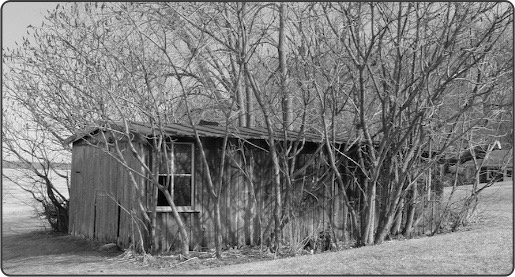
Old Towne became part of the corporate city limits in 1981. The request to annex was made when maintaining their own water and sewer systems, connected to Chisago City's system and paying double rates by not being in the city, no longer made financial sense. This action brought together all the old communities once known as Chisago City.
Of the original post office, general store, Forest Hotel, blacksmith, church, and houses, few are left. The strangest remnant of all is perhaps the remains of the milling operation that existed during the 1800s.
Zion Lutheran Church
1857 Map showing Deer Garden, Chisago City Old Towne, the bridge and road to Wyoming.
150 years ago, traveling around the County was not as easy as it is today. As the map above shows there was no major road where the railroad line would be built in 1880, or where Highway 8 is today. The way to the west was actually a bridge between Big and Little Green Lakes. The way to the east was along the southern edge of Chisago Lake branching out to Centre City and Taylor's Falls (original spellings) or going to the Osceola landing. For twenty years, many Chisago City residents attended church services in Center City by rowing across Chisago Lake or when the water was low to a dock in Lindstrom and walking the additional 6 miles to reach the Chisago Lake Lutheran Church (established 1854.)
Finally, in 1874, Chisago City residents voted to form a congregation located closer to their homes: the Swedish Evangelical Lutheran Church - later to be known as Zion Lutheran Church. By the end of that first year, membership included 113 adults and 106 children.
Original church built in 1875
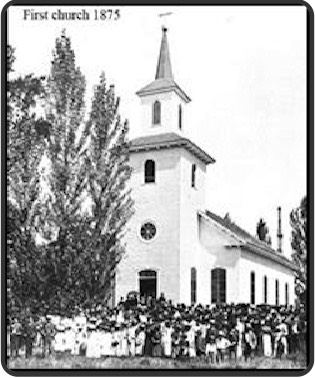
1894 congregation
Construction on the first sanctuary began in May of 1875. In 1876, the County Seat was moved from Chisago City to Center City and the newly vacated Chisago County Court house was purchased by the church and remodeled for use as a parsonage. In 1898, the church was enlarged to seat 600 people.
In 1908, like all of the original buildings in “Old Towne” Chisago City, the church burned down. The parishioners had two choices: rebuild on the original site, or relocate to the north where the railroad, most businesses, and more and more homes were situated. The decision was made to rebuild on the original site at a cost of $14,000.
The lakes and the roads to navigate around them caused challenges for the early Chisago City community. Chisago's first school was on the east side of Green Lake but after the bridge was no longer maintained another was constructed on the west along what was then the road to Wyoming. Similarly, Zion has a cemetary on the east side of Green Lake which, given todays roads, is in a location quite a distance from the church. More logically located are Zion's other cemeteries, one on Green Lake to the south of the church and one across Old Towne Road.
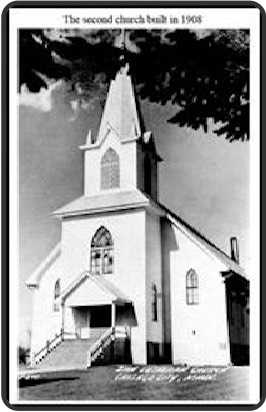
Beginning in 1920, Zion’s congregation had grown to such an extent that further space was needed. Chisago City's first school building had moved from Old Towne to the corner of Stinson Avenue and Old Towne Road. It soon bcame too small and was moved across Old Towne Road to be used as a private residence. A new larger wooden building was constructed to serve the growing population. In the early 1900s this building was also abandonded in favor of an all grade new brick building along highway 8. It was the wooden school building on the corner of Old Towne Road and Stinson Ave. that was then used by Zion for “Circle”, choir practice, and evening worship services. Use of this facility continued until a new education building was constructed in 1970.
An enclosed walkway (between the education building and the church) was built in the mid-1980’s. In 2002, the parsonage was physically moved off the site to serve as a single-family home within the area. In 2004, the education building and its connection to the church was remodeled.
Margaret S. Parmly Residence
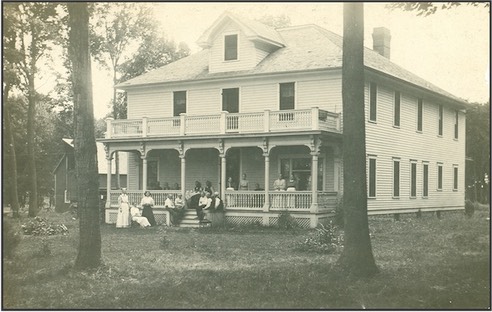
More than 100 years ago, the Reverend C. A. Hultkrans had a vision: “Many of our church's [parishioners] were approaching the evening of their life, after a long day of toil and labor, and were longing for a peaceful close of their day.” And, as a result of this vision, the first nursing home in the county was created. In 1904, the Bethesda Old People’s Home opened its doors – free of charge – to practicing Lutherans from Bayport to Almelund.
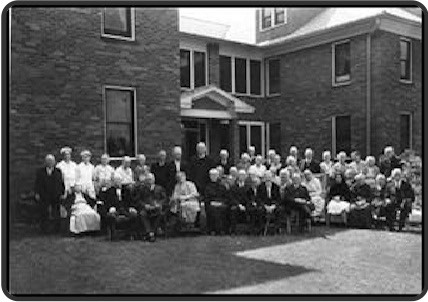
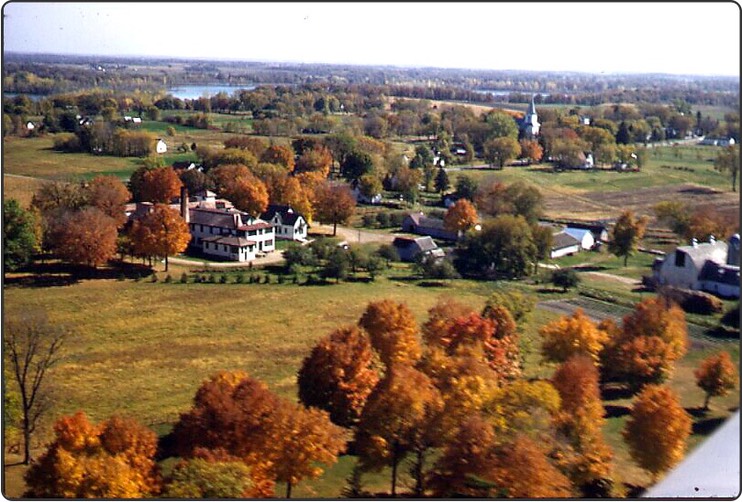
In 1904, Martha Matson was its first Matron, and ran the facility until 1932 when she became one of its residents. Eleanora Slattengren took over Matron responsibilities until 1954. There was one farmhand who was responsible for tending all the animals on the property and growing all the crops needed to feed the residents and staff. The residents assisted him in these chores, in exchange for their free room and board, until they became too frail. The “Willing Workers” rounded out the rest of the staff; they were paid female volunteers who lived at the facility and took care of the infirm.
Clips were taken by Victor Nulton and provided by his nephew Rev. Paul Nulton along with the color aerial slide of the nursing home & barn above.
July 4th 1952 - Eleanora Slattegren, staff & residents.
September 16, 1953 - John B. Carlson and Mr. Magne flailing grain at Bethesda's barn. The attached farm helped support the home's food needs.
The organization was never interested in turning a profit, only in making ends meet. By the late 1960s the future of the Chisago Lutheran Home (as it had come to be called) looked bleak. It was at this very moment that a miracle occurred. Margaret S. Parmly, a wealthy New Yorker who had never even visited Minnesota, passed away. Her estate left a $1,000,000 gift to Chisago’s home for the aged. Instead of closing its doors, the Margaret S. Parmly Residence (renamed, once again) grew and flourished.
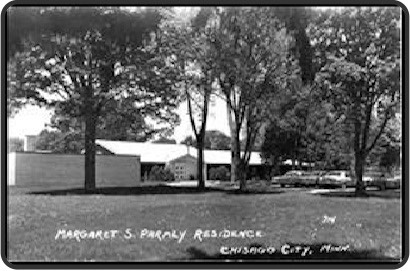
Parmly began to transform itself – this simple nursing home expanded to include complete senior services. These services now include: Alzheimer’s care, senior housing (apartments and town homes), skilled nursing care, adult day care, board and care, home health care, and the community service of Meals on Wheels.
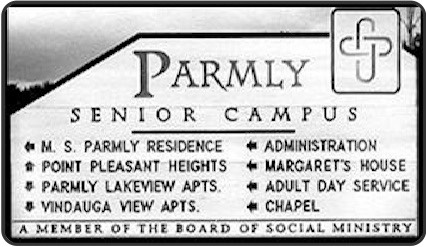
For many years the sole agent of that care was the home known variously as Ålderdomshemmet (when it was first built to care for the Swedish settlers), Bethesda Old People’s Home, Margaret S. Parmly Residence and now Parmly LifePointes.
These changes reflect the variety of needs people have as they age. In addition to those services and independent housing options Parmly added an assisted living option in 2002 with the construction of the Vindauga View Apartments.
In 2007 the latest expansion took place. This was by far the largest change that Parmly has experienced since the transition from the Bethesda Home to Parmly itself in 1973. The latest addition has 3 separate areas: a Transitional Care Unit, Isabelle’s House providing mid to late stages of memory care (Margaret’s House already provides early to mid stage care), and a wellness center with a pool.
Lakeside Transitional Care Unit on the Parmly Campus provides for recovery from a hospitalization or illness, nursing care, physical, occupational and speech therapies, as well as access to Parmly’s gardens, walking paths and other amenities.
Needs are ever changing and Parmly is currently planning an additional late stage memory care unit to be named Martha’s House. With the spirit and support of a stranger from New York and the many people willing to donate their time and their resources, Parmly has grown into a true senior care facility and as additional needs arise there is no doubt that Parmly will be there to provide them.
